Software spotlight: Lotus HAL
Lotus HAL, or Human Access Language, is an add-on for Lotus 1-2-3 1a and 2.0x that gives it a "natural language" input. It was intended to make 1-2-3 easier to use and speed up common tasks. Lotus acquired HAL when it bought GNP Development Corp. of Pasadena, California.
https://winworldpc.com/product/lotus-hal/
There is a lot of hype these days about "natural language" interfaces. Looking back, it is easy to view Lotus HAL as just a gimmick. But Lotus heavily advertised it, and many praised it as a game changer.
Spreadsheet clone makers were concerned they would have to replicate this functionality in their own spreadsheets, raising development costs. Add-on vendors were also concerned that Lotus producing their own add-ons with access to undocumented internals could present unfair competition. It was briefly conceivable that HAL could become a standard spreadsheet manipulation language much in the same way that Structured Query Language, at the time, was becoming a standard in databases.
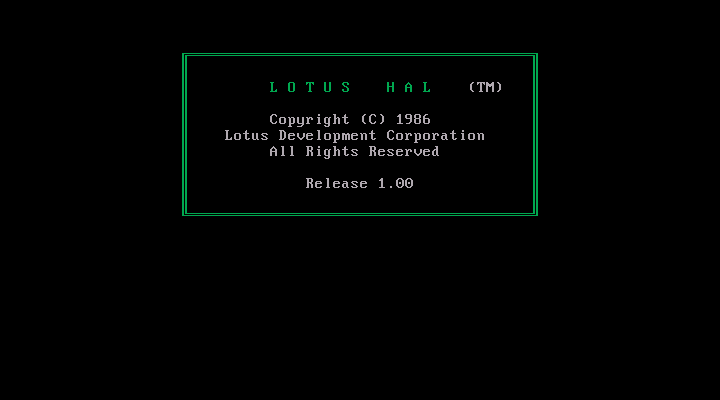
Lotus HAL works with Lotus 1-2-3 2.01 Government Edition, so you can run it without worrying about 1-2-3's copy protection. HAL itself is not copy protected. Once installed, you run the HAL program and it loads 1-2-3.
With Lotus HAL, you press the backslash "\" key and type in a request. In plain English. Sort of.
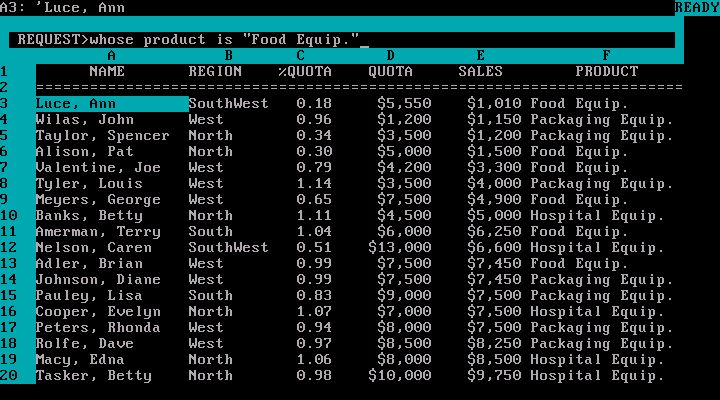
If you have ever played an Infocom text interactive fiction game, or similar, you will know that the very first thing you must do is learn the interpreter's vocabulary.
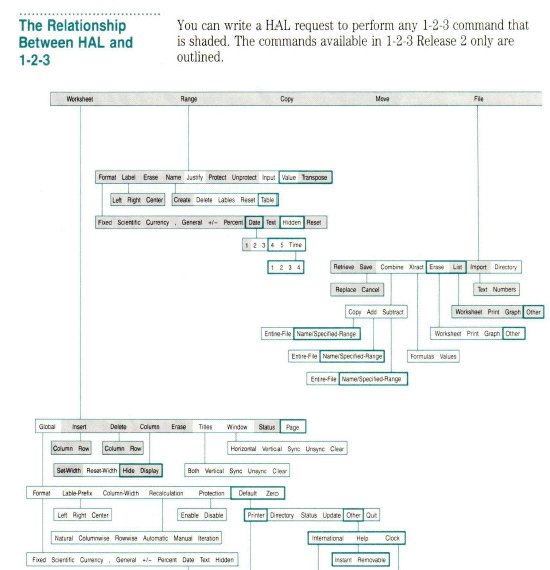
Lotus HAL is no different in this regard. The manual gives you a list of words that HAL recognizes, and terms that it uses to interact with the spreadsheet.
You may word your request in a variety of ways. You may use terms like "it" or "this" to refer to current objects. You may abbreviate some terms. You may combine multiple actions in to one request. Many of the things you can request would take multiple steps in 1-2-3 itself, or learning more about its operation and formulas.
With the English language, there are some ambiguities. Some words can be misinterpreted as column labels, for example. HAL also simplifies some steps by making assumption that you would otherwise have to spend time specifying through the Lotus menus.
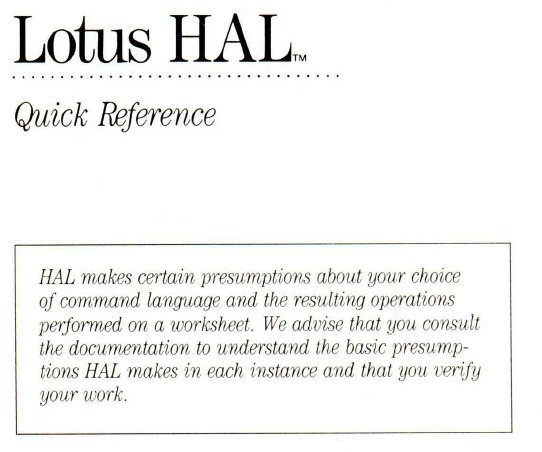
Providing a text-based interface is not all that HAL does. It adds some new capabilities to Lotus 1-2-3.
This includes:
- Creating dynamic links between worksheets (tehcnially a kludge)
- Adds on screen lists of formulas
- A search and replace
- Easier entering of sequential data
- Simplified macro creation
- An Undo command (nope, 2.0x did not have that!)
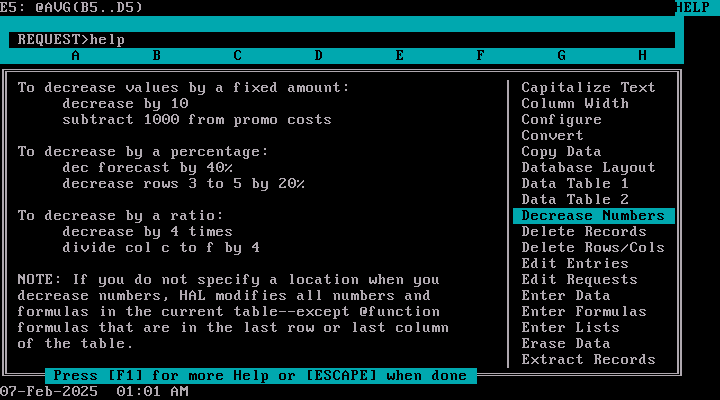
To me, this all seems very backwards. I've used many command-line environments and tools over the years, and staring at an empty prompt not knowing exactly what the result is going to be, is the opposite of what most computer users of the time called "friendly".
Even though it is English, I must learn its terse language, and carefully construct a request in order to get the right results. Effectively, this is yet another programming language.
You see that with chatbot AIs too - if you don't state your request properly, you will get a very well worded, authoritative sounding wrong answer.
However, being a programming language not a bad thing. HAL requests can be stored and played back, so they can act as a scripting language.
But if you are a high-up executive with dreams of just talking to your computer in the same way you talk to your secretary, then you will be disappointed.
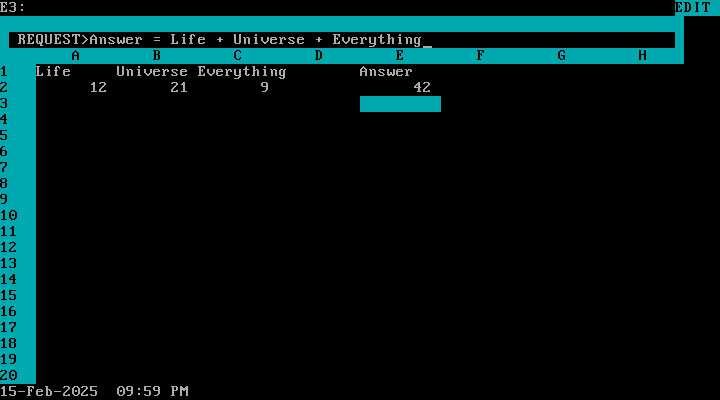
(But you didn't understand the question!)
There are some limitations to HAL. You can't specify everything from the prompt. And it does not ask for more information or confirmation before most actions. If I try to enter random things that make sense to me, it just sits there like a lump on a log, with no explanation as to what it expects.
There was a scathing review of Lotus HAL by Charles Petzold, who was also well known for promoting Microsoft Windows programming:
InfoWorld: "And Here Comes HAL"
"One of the most dangerous things you can have around the office is a computer program that seems to be smarter than it actually is, and that is exactly what HAL is."
So why did Lotus push this? Well, I think it boiled down to the non-language related features this product added to Lotus 1-2-3. Some of the competing spreadsheets were getting these features, so by acquiring HAL, Lotus could instantly claim they also had these features even though they were not built in yet.
Meanwhile, over on the Apple Macintosh, there was this new spreadsheet brewing called Microsoft Excel where you could do some of this stuff just by point and clicking.
I don't know, does anyone tell Clippy to "average all columns" in current Excel?
Lotus 1-2-3 remained popular in to the early 1990s, but only in the MS-DOS world. Looking at HAL it becomes much clearer that Lotus was heading in the wrong direction.
https://winworldpc.com/product/lotus-hal/
There is a lot of hype these days about "natural language" interfaces. Looking back, it is easy to view Lotus HAL as just a gimmick. But Lotus heavily advertised it, and many praised it as a game changer.
Spreadsheet clone makers were concerned they would have to replicate this functionality in their own spreadsheets, raising development costs. Add-on vendors were also concerned that Lotus producing their own add-ons with access to undocumented internals could present unfair competition. It was briefly conceivable that HAL could become a standard spreadsheet manipulation language much in the same way that Structured Query Language, at the time, was becoming a standard in databases.

Lotus HAL works with Lotus 1-2-3 2.01 Government Edition, so you can run it without worrying about 1-2-3's copy protection. HAL itself is not copy protected. Once installed, you run the HAL program and it loads 1-2-3.
With Lotus HAL, you press the backslash "\" key and type in a request. In plain English. Sort of.

If you have ever played an Infocom text interactive fiction game, or similar, you will know that the very first thing you must do is learn the interpreter's vocabulary.

Lotus HAL is no different in this regard. The manual gives you a list of words that HAL recognizes, and terms that it uses to interact with the spreadsheet.
You may word your request in a variety of ways. You may use terms like "it" or "this" to refer to current objects. You may abbreviate some terms. You may combine multiple actions in to one request. Many of the things you can request would take multiple steps in 1-2-3 itself, or learning more about its operation and formulas.
With the English language, there are some ambiguities. Some words can be misinterpreted as column labels, for example. HAL also simplifies some steps by making assumption that you would otherwise have to spend time specifying through the Lotus menus.

Providing a text-based interface is not all that HAL does. It adds some new capabilities to Lotus 1-2-3.
This includes:
- Creating dynamic links between worksheets (tehcnially a kludge)
- Adds on screen lists of formulas
- A search and replace
- Easier entering of sequential data
- Simplified macro creation
- An Undo command (nope, 2.0x did not have that!)

To me, this all seems very backwards. I've used many command-line environments and tools over the years, and staring at an empty prompt not knowing exactly what the result is going to be, is the opposite of what most computer users of the time called "friendly".
Even though it is English, I must learn its terse language, and carefully construct a request in order to get the right results. Effectively, this is yet another programming language.
You see that with chatbot AIs too - if you don't state your request properly, you will get a very well worded, authoritative sounding wrong answer.
However, being a programming language not a bad thing. HAL requests can be stored and played back, so they can act as a scripting language.
But if you are a high-up executive with dreams of just talking to your computer in the same way you talk to your secretary, then you will be disappointed.

(But you didn't understand the question!)
There are some limitations to HAL. You can't specify everything from the prompt. And it does not ask for more information or confirmation before most actions. If I try to enter random things that make sense to me, it just sits there like a lump on a log, with no explanation as to what it expects.
There was a scathing review of Lotus HAL by Charles Petzold, who was also well known for promoting Microsoft Windows programming:
InfoWorld: "And Here Comes HAL"
"One of the most dangerous things you can have around the office is a computer program that seems to be smarter than it actually is, and that is exactly what HAL is."
So why did Lotus push this? Well, I think it boiled down to the non-language related features this product added to Lotus 1-2-3. Some of the competing spreadsheets were getting these features, so by acquiring HAL, Lotus could instantly claim they also had these features even though they were not built in yet.
Meanwhile, over on the Apple Macintosh, there was this new spreadsheet brewing called Microsoft Excel where you could do some of this stuff just by point and clicking.
I don't know, does anyone tell Clippy to "average all columns" in current Excel?
Lotus 1-2-3 remained popular in to the early 1990s, but only in the MS-DOS world. Looking at HAL it becomes much clearer that Lotus was heading in the wrong direction.

Comments
https://winworldpc.com/product/ibm-personal-decision-series-english-access-edition/100